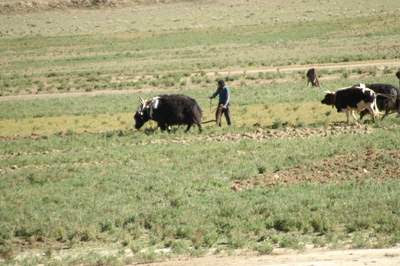 Dear Gentle Reader,
Dear Gentle Reader,I suppose if the title image for "Tales from the Field" is a barley field in Tibet, then I ought to write about that field.
Your heroine and your scribe passed numerous fields as we travelled in Tibet.
This field is in western Tibet, two thirds of the way to Mt. Everest from Lhasa; it is very stony, very hard, and quite dry.
While travelling, we could tell when we entered new communities in Tibet because the shooks of grain (the shape of the pile of harvested grain that dries as it waits to be collected) would change as the regions changed.

Everything was done by hand; there were no machines other than the simplest; a blade of steel to harvest the crop and a simple blade of wood to plough the field.

The clearing, the sowing, and the harvesting are all done manually.


We stopped the car here to try to get a feel for this life with our rudimentary Tibetan.
Your humble scribe tried harvesting, and did miserably. The Tibetan housewife laughed uproariously and offered what was arguably the best yak butter tea of the whole trip to cheer your scribe up. She also used that as bolstering argument in her quest for a higher sum of money. It was good tea; your scribe yielded easily.
Yak butter tea is a bit of an acquired taste, and by the end of the trip, especially after a two litre marathon of yak butter tea to maintain one set of hosts' honour, your scribe grew tired (and sick) of it, but it really ought to be tried at least three times.
The best I can do to describe it is to say that it is salty, and a bit rancidy, with a heady, gamey aroma and a very faint undertaste of tea.
Your scribe knows that does not sound too appetizing, and frequently it was not that appetizing. But, occasionally, it was very nice. The harvesting lady shown above knew how to harvest and she also knew how to make a mean cuppa.
Yak butter tea tastes much better in the field than it does in the restaurants catering to foreigners in Lhasa (Everything in Lhasa caters to tourists). Just so that you know. So don't stop trying after Lhasa. Perservere. Acquire the taste.
Back to the field.
Finally, once the fields were harvested and cleared, they had to be ploughed for the next year's crop.
Ploughing was done with yaks or with oxen, either with one or two animals, but the plough would be a stick of wood that the farmer would wrestle with.


Tibetan ploughing scenes looked like old, silver gelatin photos I have seen in museums showing homesteaders working the fields in their first spring in Canada.
So that is that.
Oh.
The post's title includes "tsampas" too. I guess I ought to not forget that.
As you can see from these photos, there is not a lot to be had from the environment. Tibetans have it rough.
The two main food sources for Tibetans are yaks (for yak butter tea) and barley.
Barley flour is ground up finely and is then roasted.
That roasted barley flour is tsampas.
So tsampas is roasted, dry, powdery flour.
In logistical terms, it is light, easy to pack (since it will fit into any container), and therefore it is easy to carry. These travel characteristics are very useful and advantageous for people that undertake massive religious treks in the mountainous Himalayas.
When walking or working, Tibetans put tsampas in their mouth and then they slowly chew it.
Because putting Tsampas is identical to putting dry flour in your mouth, well, roasted dry flour, it takes a while for the tsampas to be wet enough to swallow.
This means that the tsampas spends more time in your mouth than you might normally keep flour in your mouth.
From a taste-explosion, michelin star seeking, zagat reference questing perspective, having roasted, dried flour in your mouth for a long time is not such a good thing.
However, from a nutritional perspective this is good because roasted flour contains a lot of carbohydrates (think powdered toast or pasta).
The enzymes that break down carbohydrates to allow for their utilization in your body are only active in your mouth, so, if the tsampas spends more time in someone's mouth, then the enzymes have more time to break down more of the tsampas into a useable, nutrient and energy rich paste. (Mmmmm.)
This means that the Tibetans are far more efficient at extracting energy from their tsampas than most Westerners are with bread or pasta and than most Asians are with rice.
It is fortunate that Tibetans extract more energy from the tsampas, because there is not much of anything grown, and they need to get the last ounce of usefulness of everything that they consume.

And that is a Tibetan tale from the field.
Tschuess,
Chris, Regina, and Pommes mit yak butter, but he seems to be drawing his nose back...









No comments:
Post a Comment